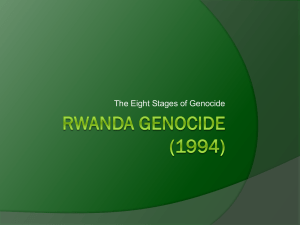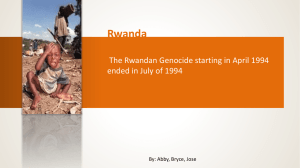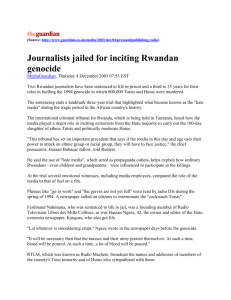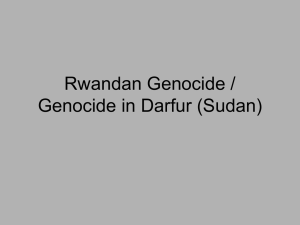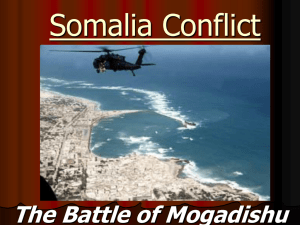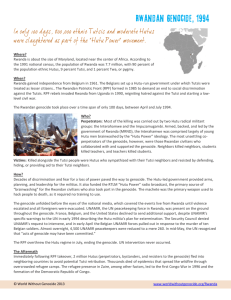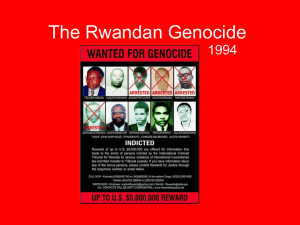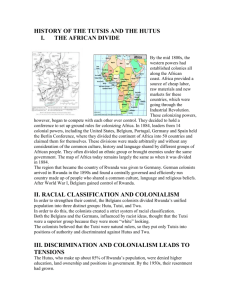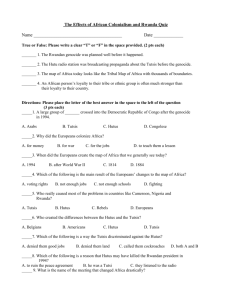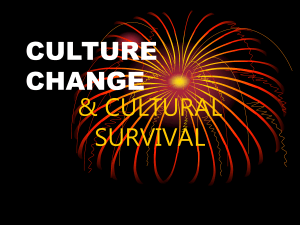Rwanda Genocide
advertisement
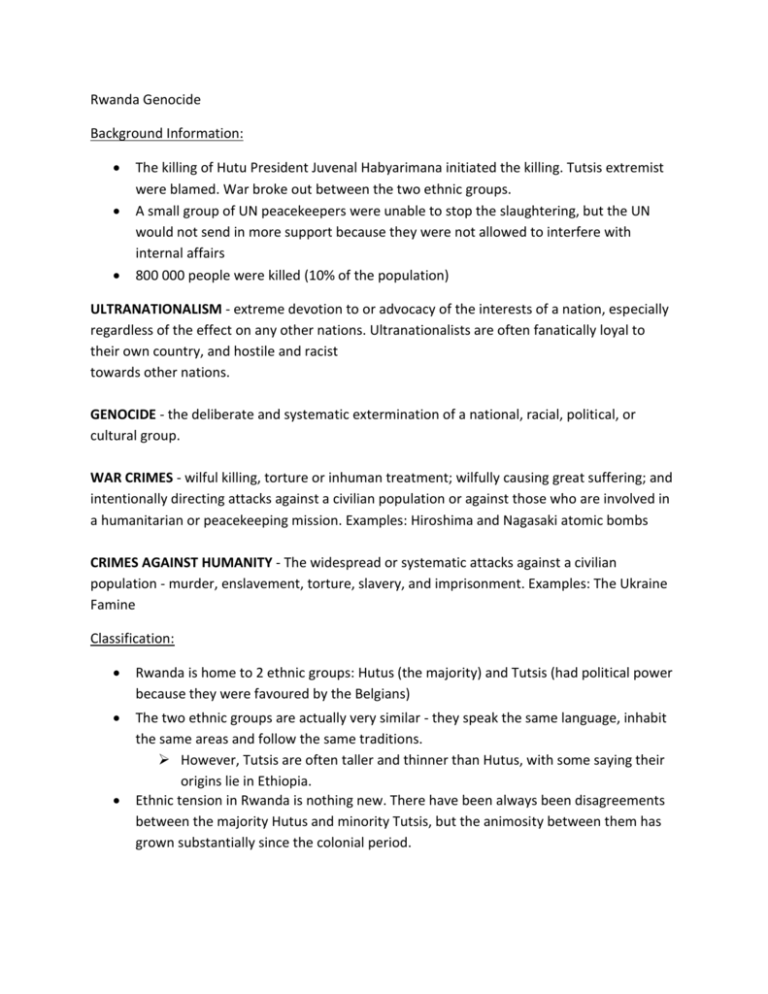
Rwanda Genocide Background Information: The killing of Hutu President Juvenal Habyarimana initiated the killing. Tutsis extremist were blamed. War broke out between the two ethnic groups. A small group of UN peacekeepers were unable to stop the slaughtering, but the UN would not send in more support because they were not allowed to interfere with internal affairs 800 000 people were killed (10% of the population) ULTRANATIONALISM - extreme devotion to or advocacy of the interests of a nation, especially regardless of the effect on any other nations. Ultranationalists are often fanatically loyal to their own country, and hostile and racist towards other nations. GENOCIDE - the deliberate and systematic extermination of a national, racial, political, or cultural group. WAR CRIMES - wilful killing, torture or inhuman treatment; wilfully causing great suffering; and intentionally directing attacks against a civilian population or against those who are involved in a humanitarian or peacekeeping mission. Examples: Hiroshima and Nagasaki atomic bombs CRIMES AGAINST HUMANITY - The widespread or systematic attacks against a civilian population - murder, enslavement, torture, slavery, and imprisonment. Examples: The Ukraine Famine Classification: Rwanda is home to 2 ethnic groups: Hutus (the majority) and Tutsis (had political power because they were favoured by the Belgians) The two ethnic groups are actually very similar - they speak the same language, inhabit the same areas and follow the same traditions. However, Tutsis are often taller and thinner than Hutus, with some saying their origins lie in Ethiopia. Ethnic tension in Rwanda is nothing new. There have been always been disagreements between the majority Hutus and minority Tutsis, but the animosity between them has grown substantially since the colonial period. Belgians distinguished between Hutus and Tutsis by nose size, height & eye type. Another indicator to distinguish Hutu farmers from Tutsi pastoralists was the number of cattle owned Symbolism & Dehumanization: Rwandan Hutu hate radio referred to Tutsis as ‘cockroaches’ The Rwanda Genocide the Hutu and Tutsi were labeled and symbolized as individual groups. Though Hutu and Tutsi were forbidden words in Burundi until the 1980's, codewords replaced them. If widely supported, however, denial of symbolization can be powerful as well After the genocide, the Rwandan cattle herders became the symbol of recovery. Polarization & Dehumanization: Hutu ultranationalists used radio to wage a propaganda campaign against the Tutsis Radio was used because it was the most popular form of mass communication, and many people couldn’t read or write Specific people were labelled as targets Some broadcast urged killing all Tutsis Congratulations were also announce on air The first to be killed in a genocide are moderates from the killing group who oppose the extremists: Tutsi Archbishop in Burundi, Hutu Supreme Court Chief Justice Organization: An unofficial militia group called the Interahamwe (meaning those who attack together) was mobilised. At its peak, this group was 30,000-strong. Death squads were trained for mass murder and then forced everyone to participate, spreading hysteria and overcoming individual resistance. Preparation: In Rwanda, identity cards show a person’s ethnicity. In the genocide, Tutsis could then be easily pulled from cars at roadblocks and murdered. Throwing away cards did not help because anyone could not prove he/she is a Hutu, was presumed to be a Tutsi. Hutu militiamen conducted crude mouth exams to test claims of Hutu identity. Extermination: The Rwanda Genocide was the results of revenge killings between the Hutus and the Tutsis. Victims’ bodies were mutilated, buried in mass graves, or burnt. Although most genocide is sponsored and financed by the state, the armed forces often work Denial: During and after every genocide, the perpetrators deny they committed the crime. They portray their murders as justified killing during war or repression of terrorism. They dig up and dispose of the bodies and try to minimize the number of victims. They try to blame the victims, often claiming that the victims’ own behavior brought on the killing All of these strategies of denial operated during and after the Rwandan genocide. The presence of the Rwandan government representative at the very U.N. Security Council meetings that considered the situation provided an ideal forum for such denial. Since the genocide, despite massive evidence against them, this denial by perpetrators has continued both at the International Criminal Tribunal for Rwanda and in Rwandan courts and prisons.
